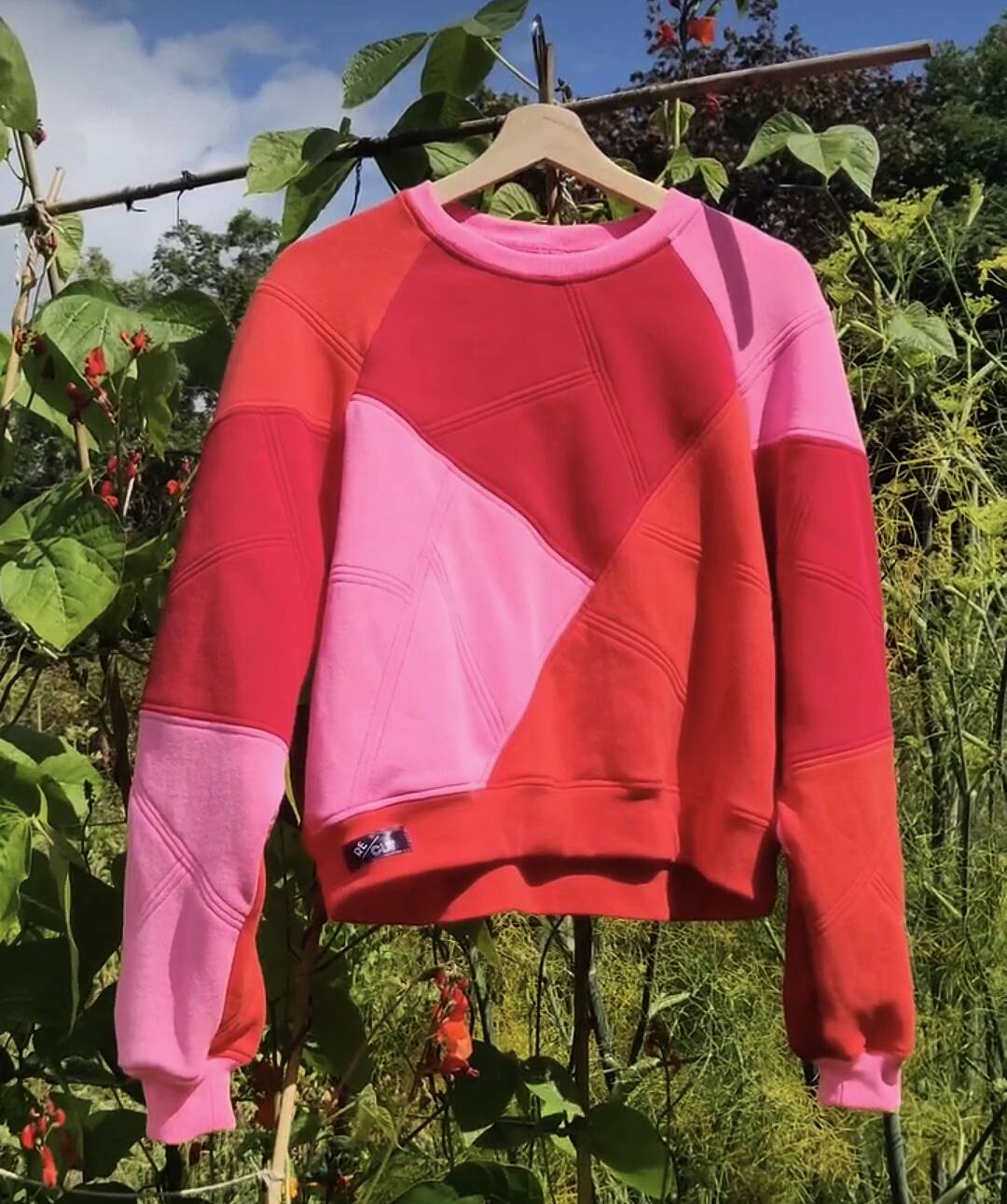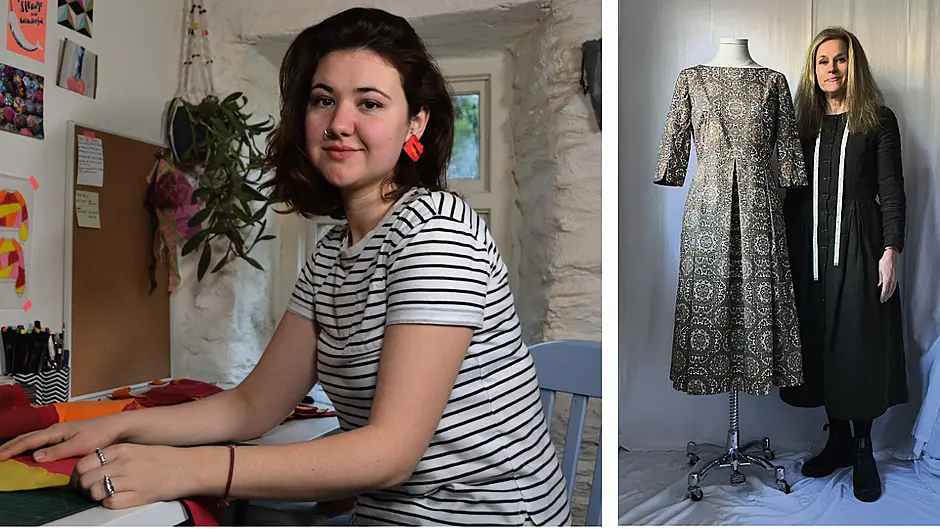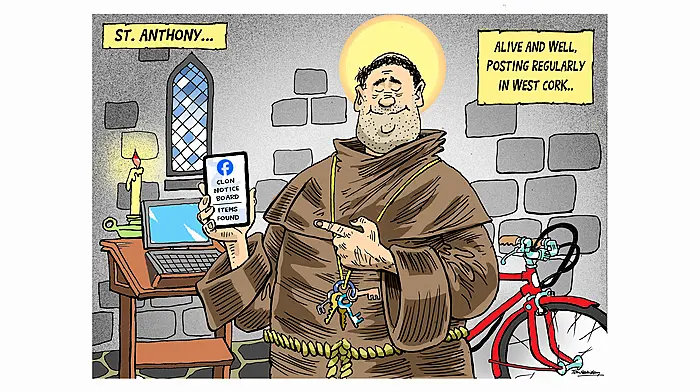In a world of fast fashion (and everything else), people are turning to sustainability more and more – Kathryn M Crowley speaks to two West Cork designers doing their bit for the environment.
THE postman is busy: ‘They can’t stop buying,’ he tells me, mentioning a certain website. I check it. T-shirts for a fiver, hoodies for €7. Fast fashion is rubbish, though. Literally. In Ireland, 35 kg of clothes (on average) is dumped per person annually. Less than 1% of it is recycled into new items.
In Ballydehob, designer Abalonia Blue transforms hoodies, old duvets, and more.
‘I learned hand sewing as a kid and always had an interest in making clothes. I got a sewing machine as a teenager but was nervous to use it,’ she recalls.
‘During college I enjoyed working with upcycled materials. You design as you go and problem solve, seeing potential in all types of fabric. I started saving the scraps as I couldn’t stand the idea of them going in the bin.
‘It was a few years after that I started to use those bits in patchwork and then I got really into it and started to take apart old clothes and reuse the fabric. I enjoy mixing textures and colours together.’
Abalonia believes that more and more of us need to slow down and become more conscious of our purchases, and how they affect the environment, and the people making them.
‘So many products are labelled as sustainable now, but do we really need them all? Our consumer culture makes us think we need things we really don’t,’ she says.
‘We should try think before we buy: “Do I really need this? Can I get it second hand? Will I treasure this?”
‘Another thing to keep in mind is once you purchase something it is then your responsibility, you should try to use it as much as possible, mend it if needed and make sure once it’s life is done it’s upcycled, recycled or disposed of properly.’
 One of Abalonia’s finished designs, made completely with recycled materials.
One of Abalonia’s finished designs, made completely with recycled materials.
For those looking to try out upcycling with some old clothes that are lying in the back of a wardrobe, Abalonia says to start simple.
‘Try something within your skill set, then go from there. Look to see if there’s a class or mending group in your area. There’s so much information online which is great but can sometimes be overwhelming,’ she says. An in-person class is a great way to get you started and give you confidence plus sewing in a group setting is more motivating. Most importantly just have fun with it. It’s easy to get bogged down by thinking about it too much or trying to make things perfect.’
When not making clothing or accessories, she walks with her dogs, enjoys sea swimming, foraging, and drying flowers. Charity shop rummages are fun.
‘I’m getting married in the beginning of the summer so most of my energy is going towards that at the moment,’ she says. ‘During the summer I hope to get back into the studio to create more, I have a lot of ideas brewing, so excited to bring them to life. A friend and I are also running monthly clothes swaps and social repair.’
Those monthly clothes shops take place in Oasis Arts Cafe in Ballydehob, and invite people to bring up to five gently-used items of clothing to swap for something else. The next event takes place on Sunday, April 13th from 4-8pm and also includes a ‘repair social’ where you can mend or embellish your clothes while enjoying a cup of tea and cake with others.
‘It’s a relaxed afternoon where people can swap their clothes then sit and mend together,’ says Abalonia. ‘It’s always a lovely environment.’
Ireland has a rich history of designers and garment makers, as Schull’s Tamsin Blackbourn points out.
 Abalonia’s design process.
Abalonia’s design process.
‘As recently as the 1990s, Irish factories were fully able to make garments, from the processing of flax to linen, through the many processes, including scutching, spinning, weaving, dyeing and finishing, to the sewing on of the last button in the numerous factories that sold Irish made goods all over the world,’ she says.
‘Then production was off-shored to developing countries in the East where labour costs were much cheaper. Irish cloth-making looms and machinery was literally dismantled and shipped to China and the knowledge of generations of cloth makers was discarded.’
It’s a sad story for Tamsin, who points out how not only did the country lose an industry and a skilled workforce, but we lost connection to where our clothes were made and who made them within our communities.
It’s something which increases the importance of supporting small, local designers and companies, she says: ‘Small clothing companies or artisan makers are likely to be concerned about sourcing supplies locally and responsibly whereas big companies make clothing from man-made fibres because it costs them less, not because they are better fabrics. Artisan makers want to make the world better by making better things, but most big brands are motivated primarily by profit.
‘How we want to dress ourselves is about expressing the way we’d like to be in the world. It’s about connecting with the things that matter to us.
‘More than ever, fashion is about business and paying shareholders, which means selling loads and loads of clothing, and less about intelligent design or quality. Buying clothing should be an experience of lasting romance and connection in finding a garment that we adore and may even imagine passing on to the next generation.’






